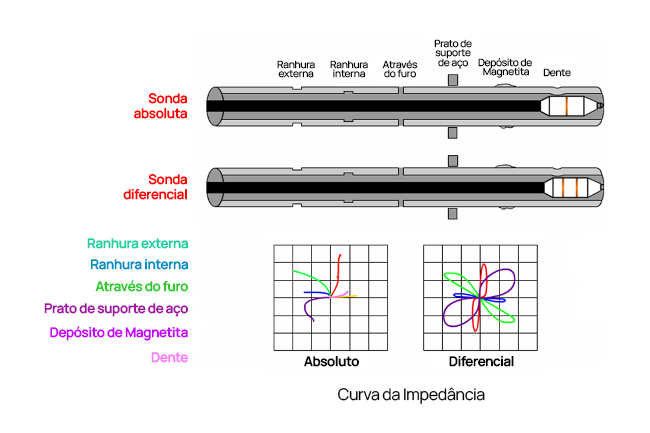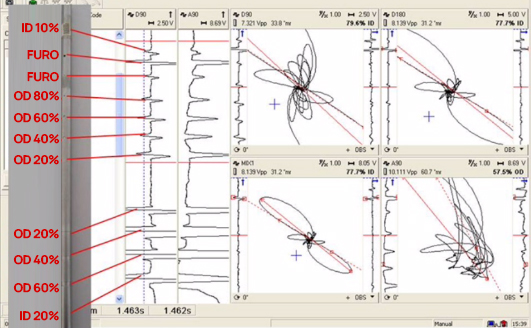ECA - TUBE INSPECTION
It is a technique of the electromagnetic method, which consists of “sweeping” the entire length of the tube using one or more probes that generate magnetic fields that induce eddy currents in the examined tubes.
The presence of discontinuities causes a disturbance in the impedance of the test system which is correlated to artificial defects with known dimensions induced and tubes similar to those tested (standard tubes). This correlation is represented by the “impedance plane”.
Among all the techniques, it is the one with the greatest sensitivity and versatility, as it is capable of detecting and measuring (with some limitations) all types of damage normally found in tubes, from localized thickness losses and extensive cracks, even circumferential, longitudinal and branched cracks, through the use of up-to-date equipment and software that allow operation with multiple frequencies, multiple absolute and differential channels and various types of probes (flexible, pancake, rotary, weld scan, coils, etc.)
The main problem observed in eddy-current inspection arises when mirrors or baffles are made of materials similar to tubes; this situation can cause “distortions” in the signals that limit the detection and dimensioning of damage. Araujo Engenharia has developed special procedures for this purpose, using specific probes, calibration standards with representative damage and knowledge of the type of damage to be detected.
The presence of discontinuities causes a disturbance in the impedance of the test system which is correlated to artificial defects with known dimensions induced and tubes similar to those tested (standard tubes). This correlation is represented by the “impedance plane”.
Among all the techniques, it is the one with the greatest sensitivity and versatility, as it is capable of detecting and measuring (with some limitations) all types of damage normally found in tubes, from localized thickness losses and extensive cracks, even circumferential, longitudinal and branched cracks, through the use of up-to-date equipment and software that allow operation with multiple frequencies, multiple absolute and differential channels and various types of probes (flexible, pancake, rotary, weld scan, coils, etc.)
The main problem observed in eddy-current inspection arises when mirrors or baffles are made of materials similar to tubes; this situation can cause “distortions” in the signals that limit the detection and dimensioning of damage. Araujo Engenharia has developed special procedures for this purpose, using specific probes, calibration standards with representative damage and knowledge of the type of damage to be detected.

Standard inspection is capable of detecting pitting, generalized and localized thinning, and axial cracks. The inspection may include the search for circumferential cracks and damage located in the regions of the mirrors, upon prior consultation, through the application of special probes.

Specific probes and procedures are used with Array technology, with 3D representation, to detect circumferential cracks in any region of the tube, including under mirrors and baffles.
A conventional eddy current probe will not allow the detection of circumferential cracks because the electromagnetic field generated is circular, and is in the same direction as the circumferential crack.
A conventional eddy current probe will not allow the detection of circumferential cracks because the electromagnetic field generated is circular, and is in the same direction as the circumferential crack.

